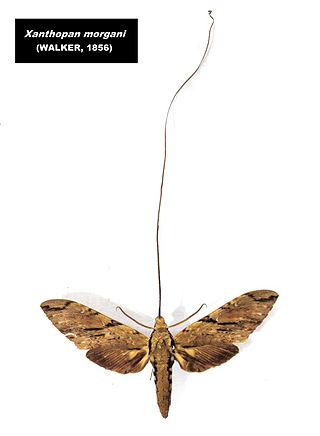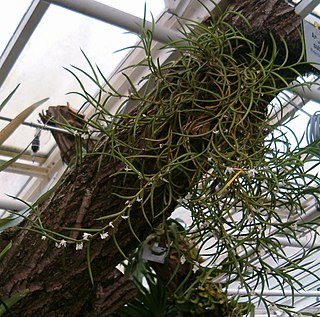
Angraecum, also known as comet orchid, is a genus of the family Orchidaceae native to tropical and South Africa, as well as Sri Lanka. It contains 223 species.

Taxodium distichum is a deciduous conifer in the family Cupressaceae. It is native to the southeastern United States. Hardy and tough, this tree adapts to a wide range of soil types, whether wet, salty, dry, or swampy. It is noted for the russet-red fall color of its lacy needles.

Abeliophyllum, the miseonnamu, Korean abeliophyllum, white forsythia, or Korean abelialeaf, is a monotypic genus of flowering plants in the olive family, Oleaceae. It consists of one species, Abeliophyllum distichumNakai, endemic to Korea, where it is endangered in the wild, occurring at only seven sites. It is related to Forsythia, but differs in having white, not yellow, flowers.
Angraecum pyriforme is a species of plant in the family Orchidaceae. It is found in western tropical Africa, to be precise in Cameroon, Ivory Coast, and Nigeria. Its natural habitat is subtropical or tropical moist montane forests. It is threatened by habitat loss.

Angraecum sanfordii is a species of plant in the family Orchidaceae. It is endemic to Cameroon, where it occurs on Mount Kupe and Mount Cameroon. It grows in submontane and montane habitat types. It is an epiphyte. It is threatened by habitat loss.

Amesiella philippinensis is a species of orchid endemic to the Island of Luzon in the Philippines. Like Vanda falcata it was mistaken as an Angraecum species, due to the white, long-spurred flowers. The plant produces rounded leaces up to 5 cm in length. Three or four white, fragrant flowers of 3 cm in width are produced on short inflorescences. The labellum is yellow in the throat. It occurs at lower altitudes than Amesiella monticola and has a shorter spur.

Xanthopan is a monotypic genus of sphinx moth, with Xanthopan morganii, commonly called Morgan's sphinx moth, as its sole species. It is a very large sphinx moth from Southern Africa and Madagascar. Little is known about its biology, though the adults have been found to visit orchids and are one of the main pollinators of several of the Madagascar endemic baobab (Adansonia) species, Adansonia perrieri or Perrier's baobab.

Angraecum mauritianum is a small, epiphytic species of orchid. It is native to Mauritius where it can still be found along roadsides. It favours low tree trunks or logs, and does not grow higher up in trees.

Paspalum distichum is a species of grass. Common names include knotgrass, water finger-grass, couch paspalum, eternity grass, gingergrass, and Thompson grass. Its native range is obscure because it has long been present on most continents, and in most areas it is certainly an introduced species. Its native range probably includes parts of the tropical Americas.
Angraecum aporoides is a species of comet orchid that can be found in Burundi, Cameroon, the Democratic Republic of the Congo, Equatorial Guinea, Gabon, Nigeria, Rwanda and São Tomé and Principe. It can be found in dense lowland forest from elevations of 20–2,400 m on Gilbertiodendron dewevrei trees.
Angraecum atlanticum is a species of comet orchid that can be found in Equatorial Guinea and Gabon. It is known from three subpopulations; in Monte Alén National Park in Equatorial Guinea and in Moukalaba-Doudou National Park and Ivindo National Park in Gabon. It is found in epiphyte-rich submontane forest, and in the shrubby fringes rich in Burseraceae.
Angraecum bancoense is a species of comet orchid that can be found in Cameroon, the Central African Republic, the Republic of the Congo, the Democratic Republic of the Congo, Equatorial Guinea, Gabon, Ghana, Guinea, Liberia, Nigeria, Rwanda, São Tomé and Principe and Sierra Leone. It can be found with Calamus, on Lophira alata, Macrolebium or Blighia welwitschii.
Angraecum doratophyllum is a species of comet orchid that is endemic to São Tomé and Príncipe. On São Tomé, it can be found from elevations of 850–1,600 m, growing with Syzygium guineense or with Bulbophyllum lizae. On Príncipe, it is found in shrubby vegetation at around 300 m elevation. It is threatened by deforestation for agriculture and timber.
Angraecum gabonense is a species of comet orchid that can be found in Cameroon, the Democratic Republic of the Congo, Equatorial Guinea and Gabon.
Angraecum penzigianum is a species of comet orchid that is endemic to Madagascar, and is recorded from Antsiranana, Fianarantsoa and Toamasina provinces, from elevations of 1,000–2,000 m. It is an epiphytic perennial which grows in mossy forests. However, it was previously thought to be endemic to the Andringitra Massif. It is threatened by slash-and-burn cultivation, cattle grazing, charcoal production and bush fires.

Angraecum podochiloides is a species of comet orchid that can be found in Cameroon, the Democratic Republic of the Congo, Côte d'Ivoire, Equatorial Guinea, Gabon, Ghana, Liberia and Nigeria. It can be found in dense lowland forests on Gilbertiodendron dewevrei, and in humid forests at higher elevations or low montane forests. It is an epiphyte on Dialium corbisieri or in periodically flooded marshes with Guibourtia.
Angraecum pungens is a species of comet orchid that can be found in Cameroon, the Democratic Republic of the Congo, Equatorial Guinea, Gabon and Nigeria. It is found in dense lowland forests, downstream from waterfalls, and on periodically flooded marshes with Oxystigma mannii, between elevations of 50–1,800 m. It also occurs on Terminalia catappa. It is threatened by habitat loss from agriculture and logging.

Angraecum subulatum is a species of comet orchid that can be found in Cameroon, the Democratic Republic of the Congo, Côte d'Ivoire, Equatorial Guinea, Gabon, Ghana, Guinea, Liberia, Nigeria and Sierra Leone. This species is found in lowland forests, especially those rich in Caesalpinioideae between 50 and 700 m elevation. It occurs in periodically inundated swampy forests with Raphia, Pandanus and Marantaceae, and on calcareous rock in shrubby vegetation. It has been recorded on high shaded branches of Gilbertiodendron dewevrei.

Gilbertiodendron dewevrei is a species of tree in the family Fabaceae, native to tropical rain forests in Central Africa. It is often the dominant tree species of the Guineo-Congolian rainforest. The timber is traded as limbali, and is used for construction, flooring and railway sleepers. It is also used for making boats, furniture, tool handles and joinery and for making charcoal.













